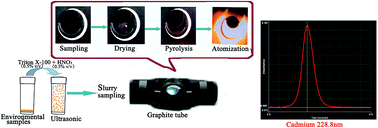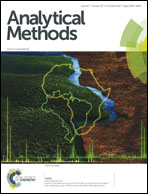Direct determination of cadmium in geological samples by slurry sampling electrothermal atomic absorption spectrometry†
Abstract
Cadmium (Cd) is an important element for the assessment of environmental pollution. An accurate and high throughput method involving slurry sampling electrothermal atomic absorption spectrometry (ETAAS) was developed to detect trace Cd content in geological samples. After sonication of the sample with 0.5% v/v HNO3 and 0.5% v/v Triton X-100 solution, the slurry was directly introduced into a graphite atomizer and detected by AAS. This simple method was shown to take 80% less time, and resulted in 90% less reagent waste than the conventional acid digestion method. Under optimized conditions (sample size ≤ 75 μm, sonication time: 20 min, pyrolysis temperature: 450 °C, and atomization temperature: 1600 °C), the characteristic mass and limit of detection for Cd were 0.8 pg and 0.002 μg g−1, respectively. The proposed method was applied to the determination of Cd in 86 soil, sediment, and rock standard reference materials (SRMs). The results for 78 of these materials were in good agreement with the reference values. The Cd levels in five limestone SRMs (GUI-1, GUI-2, DIAN-1, DIAN-2, and DIAN-3) and one clay SRM (GBW03103) were reported for the first time. The proposed method shows great potential for the direct determination of trace Cd in various geological samples.


 Please wait while we load your content...
Please wait while we load your content...